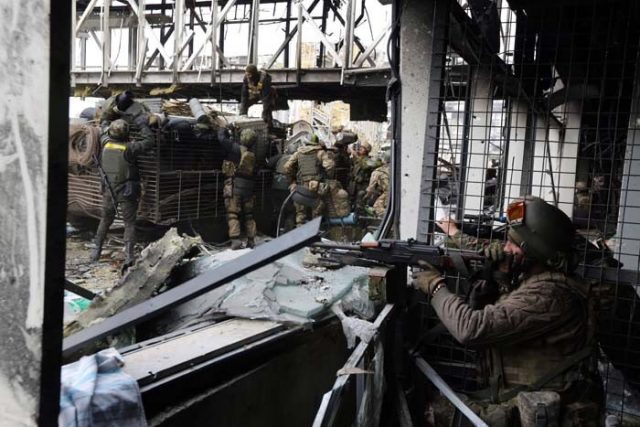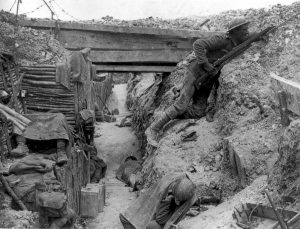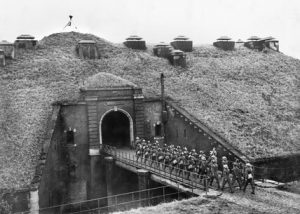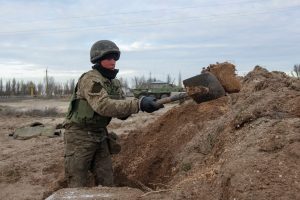Learning from the past and the present for a better protected future
When we picture digging in, it’s either one of three things. A quick, couple of feet, deep shell scrapes, dug on one of the few areas that allow it. A six foot deep, mud and rat filled position in Flanders fields or the mosquito filled hell hole of Gallipoli.
Fixed defensive positions fell out of favour after WW1. As the post war generals, who cut their teeth as junior officers, in the trenches of both sides developed a maneuverist tactical mindset. The culmination of these tactics was the German, combined arms Blitzkrieg. Speed and maneuver had returned to the battlefield. The French were slow to develop a counter to combined arms tactical approach to warfare. Like many believed the fact that any future war would be just like the last one. The French began building a massive system of fortifications called the Maginot Line. The French believed this colossal work of military engineering and believed it would hold up any German invasion. To some degree it did. It kept the Germans in their borders until the Germans tactical geniuses, such as, Von Rundstedt realized maneuver forces can exploit the failures of fixed positions. The Germans did what the French thought was impossible and drove armoured Panzer Divisions through the Ardennes forest.
But trenches and fixed positions in war didn’t end with the failure of the Maginot Line. From Kohima to Korea, to the Iran – Iraq war, they have made a regular appearance on the front line. The HERRICK and TELIC Ops have luckily been safely ensconced behind Hesco Bastion or compounds with high walls and rudimentary defences. Some haven’t touched any form of building defences, since digging a quick shell scrape in training. But not long ago digging in and building fixed positions was commonplace to every soldier from the Infantry to the Catering Corps.
Cold War Warriors, you know old and bold who bang on about how every soldier since their generation is soft. Regularly practiced digging established positions with overhead protection, line laid comms via field telephones to reduce radio emissions with little support from the Sappers. Using basic defense stores such as pickets, sand bags and wriggly tin.
These ‘speed bumps’ in the event of a Russian push out of east Germany were to provide the troops the defense against indirect fire and with the use of a individual protection kit, for nuclear fallout.
“But this is ancient history, and fuck it, it’s honking work to do when your chinstrapped” you may say! But in response, all I can say is can you put a price on good cover. The fixed trench positions of the past are having a forced renaissance since the hostilities in the Ukraine have seen down to a slow protracted fight hidden behind fake ceasefires.
Both the Ukrainian and Novorussian forces have reverted to a state of trench warfare that hasn’t been seen in Europe since the First World War. After 6,000 casualties on both sides in the first year the war came to a protracted stalemate. In an effort to consolidate what gains both sides had made. These defensive systems were near identical to each other as the training on both sides came from the Soviet style trench systems. These defenses are purely in a rural setting and heavy urban combat has slowed both Ukrainian and separatist forces to a complete standstill, as both sides are using IED’s and well defended structures with a minimum of troops to hold up greater forces. A prime example can be seen as the battle of Donetsk airport, a brand new airport built to bring European tourists to a potential Euro football championship in Ukraine.
Both sides when they held the airport turned the place into a fortress. Much like the battle of Monte Cassino, the damage gave an advantage to the defenders, as the rubble made up for their lack of defensive stores and also helped deny the interior of the airport to infiltration and armored attack. When the Ukrainian forces held the airport they fought so tenaciously that the separatist forces began calling them ‘cyborgs’ as they turned the place into Stalingrad on a smaller scale.
With a return to conventional war fighting and a high possibility of operations in the future being against a well armed enemy. Have NATO troops after 15 years of Hesco enclosed ‘safety’ lost the art of digging in? I think so. While you may have a chance to dig down to stage 4 in Kenya or first encounter if you’re a Rupert, this skill seems to have been cast to the wayside as British and American forces are focusing much of their efforts on rapid armored long range reinforcement. A few examples of this is with the US dragoon rides across Eastern Europe and the creation of strike brigades in the future for the British Army.
Little time, training and money has gone into a revision of defensive tactics since the end of the Cold War. But if a few underfunded Ukrainian soldiers with little combat engineer and combined arms support can bring Russian backed forces to a standstill imagine what could be done with a NATO combined arms battle group? I’m not envisioning NATO creating a Maginot Line in the Baltics and Eastern Europe. But by giving these troops the tools and the training from a dedicated and well supported assault pioneer platoon, the digging and building of well constructed defenses and in the rural and urban could save lives in the event of any future conflict again a conventional or hybrid threat enemy. A soldier has always taken cover, wether it was in the saps of a medieval siege or behind primitive wicker bales in the Crimea or Hesco on Herrick. NATO is losing the art of force protection and area denial.
This Kit Pest Review article was written by Callum J Bickerton. Hopefully you enjoyed it and if you have any thoughts or comments related to this article then leave a comment! This article was reposted with permission from Kitpest.
*The views and opinions expressed on this website are solely those of the original authors and contributors. These views and opinions do not necessarily represent those of Spotter Up Magazine, the administrative staff, and/or any/all contributors to this site.








